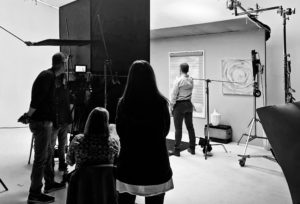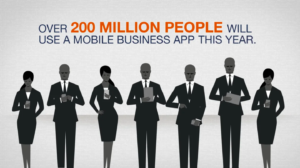With video being created across your enterprise, it’s more important than ever to keep it all brand-aligned
After more than 25 years working in B2B communication, we’ve seen a lot of brand guidelines. In PowerPoint decks, spiral-bound books and multi-page pdfs. Sometimes it’s just the basics — logo, color scheme and fonts. Other times the guidelines are more comprehensive, covering even “subtext” brand language, priority ad layouts, the correct lighting for photos, supporting graphic elements, and the full brand narrative (promise and purpose).
Yet, despite all the attention to other branding details, video is the one form of media rarely addressed as part of most companies’ brand guidelines.
Why? Every video put out by your company — whether requested by the CEO or put together by a tiny regional sales office — should be immediately identifiable as part of your brand. Achieving this cohesion requires clear, easy-to-follow guidelines for every team at every level throughout the organization.
Crafting Your B2B Video Brand
Motion
Video sets your brand in motion. Literally. And, once things move, you’ve just added several layers of communication opportunities. Is your logo going to float? Pop? Sweep? Fade? What about live-action scenes? Interviews? Graphics? Camera techniques? How does it all flow and connect? The movement is part of the message – its personality, its attitude, its energy. That’s why motion branding needs to be a key piece of your guidelines.
Of course, some of our clients provide us with motion cues like, “active”, “energized”, “personal”, “real”, and sometimes they even provide animated versions of their logo. But, when they haven’t yet translated their brand to motion, or haven’t established any branding ground rules for motion, it’s our job to translate and design the right way to “move” forward and keep the brand train on it’s tracks.
The creation of movement guidelines can happen organically as a client’s video library grows or be established comprehensively right from the start.
Picture

Several years ago, we created a series of videos for a client with very specific photography guidelines that called for “warm light from a single source that intuits the positive glow of the sun”. Our DP and lighting crew were able to capture exactly that type of lighting — indoors or out.
Sound: Music and Voice
Video doesn’t just set your brand in motion. It gives your brand a soundtrack. And possibly more than any other element, the soundtrack creates a powerful emotional connection for your audience. Imagine your brand’s music station. What does it play? It’s probably not one thing. And sound effects? Is that really a branded thing? It absolutely could be.
What about the voice of your brand? Perhaps you need a youthful sound full of energy and optimism while another brand requires an older voice conveying experience and confidence. Maybe your brand is the rugged adventurer. Maybe the guy or girl next door. What’s your brand’s accent? All voices have one. Does your brand need a country specific sound or an accent that embodies its global experience?

Big consumer brands have always invested heavily in voices like Jon Hamm, Allison Janney, Rashida Jones, Ving Rhames, and of course… Morgan Freeman. So which one would be right for your brand? For reasons of cost alone, it’s probably none of them. But fear not — thanks to the internet and some awesome advances in audio technology, you have your choice of literally thousands of top professional voiceover artists from all over the globe.
Music, sound effects, voice — working together are a branding tour de force. It’s the “feelings” thread that runs through the video and ties it all together.
Animation


Given the versatility of animation, it’s likely your company will use it at some point. Some of our clients have a library of pre-designed characters and icons to use in animation. But, typically, we work with the client to develop a motion graphics style designed to translate the brand perfectly into the world of animation.
Message
A brand-approved tag line won’t fill up a ten-minute training video or even a ninety second product launch. Our writers incorporate the vocabulary and syntax used in the branding guidelines as a foundation to build the script on.
If the branding guidelines don’t cover language in detail, then you need producers and writers who will ask the questions that clarify not only what the video needs to say but also how it will be said. We need to nail down the tone. How do you feel about humor? Use of slang? (A video that riffs on a current trend might call for it.) What about brand-specific vocabulary and spelling? How do you refer to your customers? Employees?
These are questions that will be asked eventually during video production, and having some key vocabulary defined in advance helps avoid rewrites. Text often ends up as motion graphics on screen, so it’s important to know what specific words are essential to your branding.
Budgets
In more than 25 years of experience, we have never seen this aspect of video production addressed in branding guidelines, yet it’s the one element on which every other decision rests — budget.
Addressing branding at different price points will save a lot of consternation down the line from lower-level managers. We hear their frustration all the time. We often share it. The guidelines have been made with prime-time budgets in mind but not all departments have the money for a national advertising campaign.
The truth is you don’t have to abandon branding because of budget constraints. The essential aspects of your brand can and should be translated to smaller projects. Regional and local offices will benefit from clear guidelines, and fewer resources will be wasted on projects that have to be scrapped for deviating from branding.
Why your brand needs video-specific guidelines
In B2B marketing, video has long since crossed the bridge from “nice to have” to “mission critical ” That means more and more video projects initiated by more and more departments across every strata of your company. And more opportunities for branding to run off the tracks or be completely left behind. Clearly defined brand guidelines specific to video will keep your branding consistent across departments and budget levels.
Blue Marble Is Here to Help
If your company doesn’t have specific brand guidelines for video, give us a call. Our specialists know how to set your brand in motion — whether it’s for one specific video, or creating clearly defined guidelines and examples designed to work across budgets big and small. It’s what we do. Contact us to learn more.